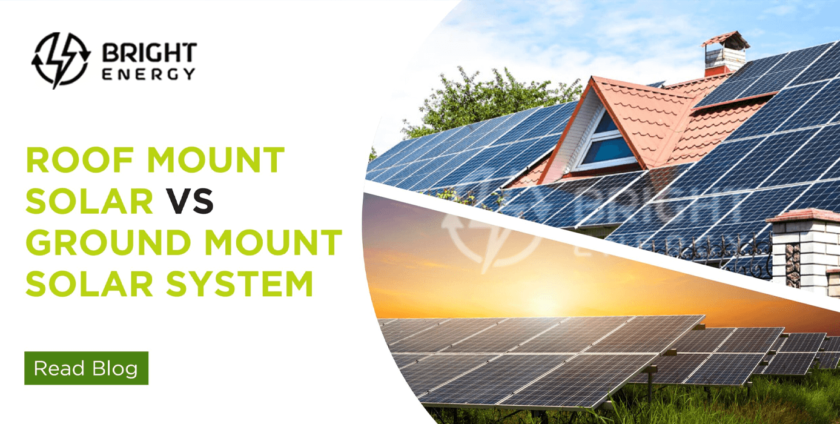
When considering solar installations, one important decision is whether to opt for a ground mount or roof mount system. Both options have their advantages and considerations, and the choice will depend on various factors such as available space, orientation, aesthetics, and maintenance. Let’s explore the pros and cons of ground mount and roof mount solar systems:
Ground Mount Solar Systems:
Ground mount solar systems are installed on the ground rather than on rooftops. Here are some of the benefits and considerations associated with ground mount installations:
Benefits:
- Optimal Orientation and Tilt:
Ground mount systems allow for flexibility in positioning the solar panels to optimize their orientation and tilt angle. This means that you can adjust the angle and direction of the panels to capture maximum sunlight throughout the day, maximizing energy production.
- Increased Energy Production:
Ground mount systems can be designed to avoid shading issues that are common with roof-mounted installations. With proper positioning and spacing, ground mount systems can achieve higher energy production compared to roof mount systems, especially in areas with shading challenges.
- Easy Maintenance and Accessibility:
Ground mount systems are easier to access for maintenance and cleaning. The panels are at ground level, eliminating the need for climbing onto roofs. This accessibility simplifies tasks such as panel cleaning, inspection, and potential repairs.
- Scalability and Expansion:
Ground mount systems offer greater scalability and the potential for future expansion. They can accommodate larger installations and can be easily expanded as your energy needs increase. Ground mount systems also provide more flexibility in adding additional panels or making adjustments to the array layout.
Considerations:
- Land Space Requirements:
Ground mount systems require available land space for installation. If you have limited land area or if the land is not suitable for solar installation (e.g., shaded areas, uneven terrain), a ground mount system may not be feasible.
- Land Use and Aesthetics:
Installing ground mount systems requires dedicating a portion of your property for Solar Panels. This may impact land use and aesthetics, especially in residential areas or landscapes where maintaining the visual appeal is essential.
- Potential Ground Disturbance:
Ground mount systems involve excavation and installation of support structures, which may result in ground disturbance. Consider any environmental or landscaping implications before opting for a ground mount system.
Roof Mount Solar Systems:
Roof mount solar systems are installed directly on rooftops. Let’s explore the benefits and considerations associated with this type of installation:
Benefits:
- Efficient Use of Space:
Roof mount systems make efficient use of available roof space, especially in urban areas where land space may be limited. By utilizing existing roof space, you can generate solar energy without needing additional land.
- Aesthetics:
Roof mount systems can be seamlessly integrated into the design of your building, maintaining the visual appeal and architectural integrity. This can be particularly advantageous for residential or commercial properties where maintaining the aesthetics of the building is important.
- Reduced Land Requirements:
Roof mount systems eliminate the need for dedicated land space, making them a suitable option for properties with limited land availability. This is especially beneficial in urban areas where ground space is limited or expensive.
Considerations:
- Roof Condition and Orientation:
The condition and orientation of your roof are crucial factors to consider. The roof condition should be structurally sound and able to support the weight of the solar panels. Additionally, the roof’s orientation and angle should be suitable for optimal solar energy production.
- Shading and Obstacles:
Shading from surrounding buildings, trees, or other obstacles can significantly impact the performance of roof mount systems. Assess the shading potential on your roof to ensure maximum sunlight exposure throughout the day.
- Maintenance Challenges:
Roof-mounted panels may require additional precautions and safety measures during maintenance tasks.
When deciding between ground mount and roof mount solar systems, several factors should be considered. Ground mount systems offer the advantage of ample space availability, allowing for flexible positioning and optimal orientation of solar panels to maximize energy production. Maintenance is also easier with ground mount systems since the panels are easily accessible at ground level. However, ground mount systems require open land space and may impact the aesthetics of the property. On the other hand, roof mount systems make efficient use of available roof space, particularly in urban areas where land is limited. They seamlessly integrate with the building’s design and maintain its aesthetics. However, roof mount systems require a structurally sound roof and may be subject to shading limitations from surrounding structures. Maintenance for roof mount systems can be more challenging and may require working at heights. Considering these factors, the choice between ground mount and roof mount solar systems ultimately depends on available space, property aesthetics, orientation, shading potential, and maintenance preferences.
Related Cool Links:
- By: Admin
- Tags: Roof Mount VS Ground Mount Solar Systems
- 0 comment

Leave a Reply